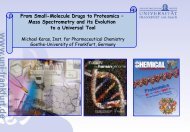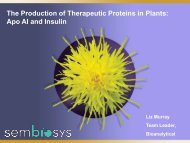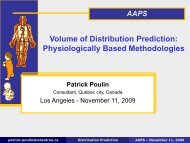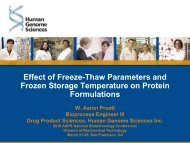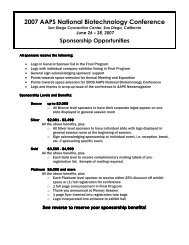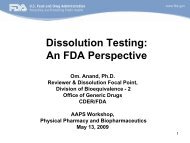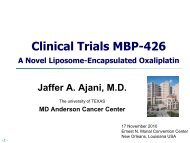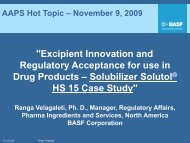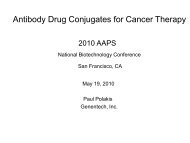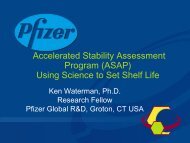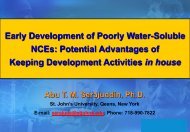US 505(b)(2) Regulatory Pathway and Strategies
US 505(b)(2) Regulatory Pathway and Strategies
US 505(b)(2) Regulatory Pathway and Strategies
- No tags were found...
You also want an ePaper? Increase the reach of your titles
YUMPU automatically turns print PDFs into web optimized ePapers that Google loves.
<strong>US</strong> <strong>505</strong>(b)(2) <strong>Regulatory</strong><strong>Pathway</strong> <strong>and</strong> <strong>Strategies</strong>Industry PerspectivesAAPS <strong>Regulatory</strong> Sciences Open Forum11/16/2010Ruth Stevens, PhD, MBA
Tale of Two Cliffs• Big Pharma Patents• GenericsLipitorFlomaxSmallPlavixmolecules100 others
Differentiated Products Now Essentially DriveEconomics of <strong>US</strong> Generics: MylanDuragesicEpiPenPaxil CRDitropan XLPlendilLevothyroxineBystolicRoyaltiesSularBase* EPSTotal EPS (%)Percent incremental contribution to 2008 cash EPS (%)1042 2 1 9Differentiatedproductscontributed**~92% of „08cash EPS271610029*Base EPS includes commodity generics, O-<strong>US</strong> generics, Matrix**Incremental contributionReference: Ronny Gal, Research Analyst, Sanford C. Bernstein & Co. Presentation atGPhA 2009 Annual Meeting
<strong>505</strong>(b)(2) ProcessPotential <strong>Regulatory</strong> <strong>Pathway</strong>s for Drug ProductsUnder DevelopmentAppropriate for drugproducts that are the sameas approved products<strong>505</strong>(j)ANDAHybrid between an ANDA[<strong>505</strong>(j)] <strong>and</strong> a full NDA[<strong>505</strong>(b)(1)]<strong>505</strong>(b)(2) NDA‘Full’ Application – Datapredominantly obtained fromstudies conducted by theSponsor<strong>505</strong>(b)(1) NDA
<strong>505</strong>(b)(2) RegulationPotential <strong>505</strong>(b)(2) C<strong>and</strong>idates:• Marketed, unapproved (DESI) drug*• PET drugs (FDG F 18, Ammonia N 13, Sodium Fluoride F 18)• Racemates• Known excipients used as active drugs*• New dosage form• Pharmacokinetic alteration• New indication• New combination• Pro-drug of approved drug* May or may not have an RLD
Defining the <strong>505</strong>(b)(2) ApplicationA <strong>505</strong>(b)(2) application is one for which one or more of the investigationsrelied upon by the applicant for approval "were not conducted by or forthe applicant <strong>and</strong> for which the applicant has not obtained a right ofreference or use from the person by or for whom the investigationswere conducted" (21 U.S.C. 355(b)(2)).
<strong>505</strong>(b)(2) NDAReference Listed Drug (RLD)• A drug product that has been previouslyapproved by the FDA• Listed in the Orange Book• Approval documents contain some of theinformation needed for your <strong>505</strong>(b)(2)7
Approved Product LabelingDrug SubstanceIndicationSafetyClinicalPharmacologyDDIPharmacokineticsReproductive8
Industry ExamplesHighlighting the Benefits of utilizing the<strong>505</strong>(b)(2) <strong>Regulatory</strong> <strong>Pathway</strong>9
Corporate StrategyThe company applies its KME development model to identify existing drugs or‘known molecular entities’ with established safety profiles which can be developed<strong>and</strong> clinically differentiated for gastrointestinal indications. The KME developmentmodel allows the company to more quickly establish the efficacy profile of itsc<strong>and</strong>idates for the target gastrointestinal indications.• <strong>505</strong>(b)(2) provides the ability to clinically differentiate from other products• Allows for market niche• Not available for ANDA (<strong>505</strong>(j)) products10
Corporate StrategyMr. Sims: Actually, because we start with drugs already approved by the FDA, we canfile for approval using the <strong>505</strong>b2 procedure rather than the full NDA (new drugapplication). Where clinical trials are required for a <strong>505</strong>b2 application, the number ofpatients required <strong>and</strong> length of time needed for those clinical trials are significantly lessthan for a new chemical entity. For example, with ESTRASORB, our Phase 1 trial had14 patients <strong>and</strong> our Phase 2 <strong>and</strong> Phase 3 trials required less than 400 patients. As theefficacy <strong>and</strong> safety of the active ingredients have already been established, thecomplexity of the studies, including the duration, is generally significantly less than foran NDA application. We believe that from the starting point of developing a drug in amicellar nanoparticle to regulatory submission, it should take no more than a three orfour year time frame, which is actually quite fast for this industry. From the point offiling, we would add about another year for FDA review <strong>and</strong> approval.• Eliminate some of the studies required for a <strong>505</strong>(b)(1)(preclinical, extensive safety <strong>and</strong> efficacy studies)• Significant financial savings• Significant time savings11http://www.novavax.com/images/TWST%200205%20Final.pdf©2005 The Wall Street Transcript, 67 Wall Street, NYC 10005Tel: (212) 952-7400 • Fax: (212) 668-9842 • Website: www.twst.com
Case Study: Colcrys TM - DESI• Colchicine Tablets for treatment of acute gout <strong>and</strong> familialMediterranean fever (Mutual Pharmaceuticals, NDAs 22-351 <strong>and</strong>22-352, July 2009)• Colchicine injection removed from the market in February, 2008because of often-fatal toxicity– Mutual showed that this toxicity was due to excessive dose<strong>and</strong>/or concomitant medications• Approved based only on literature for efficacy for the treatment offamilial Mediterranean fever (FMF) <strong>and</strong> a single Phase 3 study forthe treatment of acute gout
Case Study: Ulesfia TM - Excipient• 5% benzyl alcohol lotion for treatment of head lice (Sciele Pharma, NDA22-129, April 9, 2009)• Widely-used chemical in cosmetic industry– Never approved as active ingredient so FDA classified it as NME• Development program:– Nonclinical• Literature for repeat dose <strong>and</strong> genetic toxicology• Literature for in vitro studies demonstrating mechanism of action• 2-year toxicology <strong>and</strong> carcinogenesis studies from the National Toxicology Program– Clinical Pharmacology/Biopharmaceutics• 2 PK studies (2nd was done because presence of API in the catheter wash wasconfounded results of the 1st study)– Efficacy– Safety• 2 Phase 3 trials, 615 subjects total (240 on treatment)• Relied on its database of 8 studies (2 Phase 3, 3 Phase 2, 2 Phase 1, 1 special safetystudy)• Extensive publication reviewReceived 5 years data exclusivity
Case Study: Cafcit • Caffeine citrate for treatment of apnea of prematurity (MeadJohnson, NDA 20-793, September 21, 1999)• Development Program:– Submitted 1 double-blind trial in 58 preterm infants <strong>and</strong> 90 literaturearticles• Human PK studies from literature (19 articles)• Drug-drug interactions from literature (71 articles)– No human PK studies conducted in premature infants• Used plasma caffeine levels from subjects in the study <strong>and</strong> used special software to dopopulation PK analysisReceived orphan drug status (7 years data exclusivity) <strong>and</strong> expedited review
Pro-Drugs• Fundamental:– Where does the pro-drug become the RLD?–
Case Study: Valacyclovir• Oral tablet for treatment of herpes– Pro-drug of acyclovir– Pro-drug in systemic circulation for about 30 min– Hepatic esterases convert pro-drug to acyclovir– Similar plasma metabolic profile to acyclovir afterconversion
Valacyclovir <strong>Regulatory</strong> Path• <strong>505</strong>(b)(2) NDA as a new molecular entity– Acyclovir is RLD• Can rely on some acyclovir nonclinical & clinical data– Nonclinical studies for NME– Full Phase 1 PK program– Phase 2 dose-ranging– 1 adequate <strong>and</strong> well-controlled Phase 3 study• 5 Years marketing exclusivity
<strong>505</strong>(b)(2) Benefits• Able to earn exclusivity– 3 years: clinical studiesessential for approval– 5 years: NCE – old drugsnever approved under an NDA– 7 years: Orphan Drug18
Benefits of <strong>505</strong>(b)(2)• Get out of competitive environment of Generics• <strong>Regulatory</strong> Review Period (10 months)• May be attractive for investors– <strong>505</strong>(b)(2) allows for clinical differentiation– Market potential may be greater than generics19
<strong>505</strong>(b)(2) Risks• Imprecise development costs <strong>and</strong> timelines– ANDA‟s have few re-do‟s of BE– Recruitment of patients not naive– Uncertain dose (Phase 2)• Unknown competition– Other companies can target the same opportunity20
<strong>505</strong>(b)(2) Risks• Uncertain market acceptance– Formulary– Sales Force– Doctors– Patients21
<strong>505</strong>(b)(2) Risks• May not be attractive for investors– “Generics have less risks <strong>and</strong> better returns”• VC‟s don‟t underst<strong>and</strong> <strong>505</strong>(b)(2)• ROI may be lower than <strong>505</strong>(b)(1), or a total payoff may belower (double $50MM or $500MM)22
<strong>505</strong>(b)(2) Risks• Like Generics (<strong>505</strong>(j)):– must include patent certification(s)– include all relevant patent(s)– subject to the same Paragraph IV challenge <strong>and</strong>litigation including a 30-month stay, but it is notgranted a 180-day exclusivity23
Decision to Pursue the <strong>505</strong>(b)(2) <strong>Regulatory</strong> <strong>Pathway</strong>Considerations:• Willingness to take educated risks• In-house Expertise• Company Culture• Historical Precedence24
Thank You• <strong>Regulatory</strong> Sciences Co-Moderators– Michael Bornstein, PhD– Annette Bak, PhD, MBA• Rajneesh Taneja, PhD, RPh



